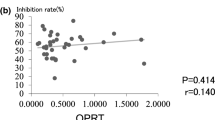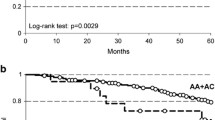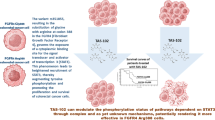Abstract
Purpose: Ferredoxin reductase (FDXR) is a putative contributor to p53-mediated apoptosis from 5-fluorouracil (5-FU) through the generation of oxidative stress in the mitochondria. However, the influence of FDXR gene expression levels on the outcome of 5-FU chemotherapy has been relatively little studied. The aim of this study is to investigate the association between FDXR gene expressions and the clinical outcome when treated by 5-FU chemotherapy, as well as the correlation of FDXR gene expressions and p53 mutation. Methods: Pre-chemotherapeutic fresh frozen samples of 33 patients with metastatic colorectal cancer, who received bolus 5-FU and leucovorin (LV) as first line chemotherapy, were studied. FDXR gene expression and p53 mutation were evaluated by real-time RT-PCR and direct sequencing, respectively. Results: FDXR gene expression was significantly higher in responding tumors compared with non-responding ones (P=0.0379). Patients with FDXR values above the cutoff value of 13.52 had a statistically longer survival than those with FDXR gene expressions below the cutoff value (P=0.0148). The 9 tumors with wild-type p53 had statistically higher FDXR gene expressions than the 14 tumors with mutant-type p53 which had sequence alterations within the “hot spot” codons, the L2–L3 loops, or frameshift (P=0.0463). Conclusions: FDXR gene expression did not affect clinical outcome in patients with wild-type p53 tumors, whereas, among patients with p53 mutant-type tumors, patients with tumors with low FDXR gene expression had a worse outcome than those with a high FDXR gene expression (P=0.0200). FDXR gene expression, which is regulated at least in part by p53, is associated with both response and survival when metastatic colorectal cancer is treated with 5-FU plus LV. In addition, analysis of p53 mutation combined with FDXR gene expression might be useful in estimating the outcome in 5-FU-treated patients.





Similar content being viewed by others
References
Allen RG,Tresini M (2000) Oxidative stress and gene regulation. Free Radic Biol Med 28:463–499
Alsner J, Yilmaz M, Guldberg P et al (2000) Heterogeneity in the clinical phenotype of TP53 mutations in breast cancer patients. Clin Cancer Res 6:3923–3931
Bunz F, Hwang PM, Torrance C et al (1999) Disruption of p53 in human cancer cells alters the responses to therapeutic agents. J Clin Invest 104:263–269
Chandra J, Samali A, Orrenius S (2000) Triggering and modulation of apoptosis by oxidative stress. Free Radic Biol Med 29:323–333
Cho Y, Gorina S, Jeffrey PD et al (1994) Crystal structure of a p53 tumor suppressor–DNA complex: understanding tumorigenic mutations. Science 265:346–355
Forslund A, Kressner U, Lonnroth C et al (2002) P53 mutations in colorectal cancer assessed in both genomic DNA and cDNA as compared to the presence of p53 LOH. Int J Oncol 21:409–415
Geisler S, Borresen-Dale AL, Johnsen H et al (2003) TP53 gene mutations predict the response to neoadjuvant treatment with 5-fluorouracil and mitomycin in locally advanced breast cancer. Clin Cancer Res 9:5582–5588
Green S,Weiss GR (1992) Southwest Oncology Group standard response criteria, endpoint definitions and toxicity criteria. Invest New Drugs 10:239–253
Gu J, Kawai H, Wiederschain D et al (2001) Mechanism of functional inactivation of a Li-Fraumeni syndrome p53 that has a mutation outside of the DNA-binding domain. Cancer Res 61:1741–1746
Hanukoglu I, Rapoport R, Weiner L et al (1993) Electron leakage from the mitochondrial NADPH-adrenodoxin reductase-adrenodoxin-P450scc (cholesterol side chain cleavage) system. Arch Biochem Biophys 305:489–498
Hwang PM, Bunz F, Yu J et al (2001) Ferredoxin reductase affects p53-dependent, 5-fluorouracil-induced apoptosis in colorectal cancer cells. Nat Med 7:1111–1117
Iacopetta B (2003) TP53 mutation in colorectal cancer. Hum Mutat 21:271–276
Ichikawa W, Uetake H, Shirota Y et al (2003) Combination of dihydropyrimidine dehydrogenase and thymidylate synthase gene expressions in primary tumors as predictive parameters for the efficacy of fluoropyrimidine-based chemotherapy for metastatic colorectal cancer. Clin Cancer Res 9:786–791
Ichikawa W, Uetake H, Shirota Y et al (2003) Both gene expression for orotate phosphoribosyltransferase and its ratio to dihydropyrimidine dehydrogenase influence outcome following fluoropyrimidine-based chemotherapy for metastatic colorectal cancer. Br J Cancer 89:1486–1492
Liu G, Chen X (2002) The ferredoxin reductase gene is regulated by the p53 family and sensitizes cells to oxidative stress-induced apoptosis. Oncogene 21:7195–7204
Longley DB, Boyer J, Allen WL et al (2002) The role of thymidylate synthase induction in modulating p53-regulated gene expression in response to 5-fluorouracil and antifolates. Cancer Res 62:2644–2649
Longley DB, Harkin DP,Johnston PG (2003) 5-fluorouracil: mechanisms of action and clinical strategies. Nat Rev Cancer 3:330–338
Lowe SW (1995) Cancer therapy and p53. Curr Opin Oncol 7:547–553
Meyerhardt JA,Mayer RJ (2005) Systemic therapy for colorectal cancer. N Engl J Med 352:476–487
Powell B, Soong R, Iacopetta B et al (2000) Prognostic significance of mutations to different structural and functional regions of the p53 gene in breast cancer. Clin Cancer Res 6:443–451
Rapoport R, Sklan D,Hanukoglu I (1995) Electron leakage from the adrenal cortex mitochondrial P450scc and P450c11 systems: NADPH and steroid dependence. Arch Biochem Biophys 317:412–416
Russo A, Bazan V, Iacopetta B et al (2005) The TP53 colorectal cancer international collaborative study on the prognostic and predictive significance of p53 mutation: influence of tumor site, type of mutation, and adjuvant treatment. J Clin Oncol 23:7518–7528
Sjogren S, Inganas M, Norberg T et al (1996) The p53 gene in breast cancer: prognostic value of complementary DNA sequencing versus immunohistochemistry. J Natl Cancer Inst 88:173–182
Soussi T,Beroud C (2001) Assessing TP53 status in human tumours to evaluate clinical outcome. Nat Rev Cancer 1:233–240
Soussi T,Beroud C (2003) Significance of TP53 mutations in human cancer: a critical analysis of mutations at CpG dinucleotides. Hum Mutat 21:192–200
Soussi T, Dehouche K, Beroud C (2000) p53 website and analysis of p53 gene mutations in human cancer: forging a link between epidemiology and carcinogenesis. Hum Mutat 15:105–113
Yoshinare K, Kubota T, Watanabe M et al (2003) Gene expression in colorectal cancer and in vitro chemosensitivity to 5-fluorouracil: a study of 88 surgical specimens. Cancer Sci 94:633–638
Yu J, Marsh S, Ahluwalia R et al (2003) Ferredoxin reductase: pharmacogenomic assessment in colorectal cancer. Cancer Res 63:6170–6173
Zweig MH,Campbell G (1993) Receiver-operating characteristic (ROC) plots: a fundamental evaluation tool in clinical medicine. Clin Chem 39:561–577
Acknowledgment
The authors are indebted to Prof. J. Patrick Barron of the International Medical Communications Center of Tokyo Medical University for his review of this manuscript, and Mr. Nobutaka Samejima for preparing the article. This work was supported, in part, by a Grant-in-Aid for Scientific Research from Ministry of Education, Culture, Sports and Technology.
Author information
Authors and Affiliations
Corresponding author
Rights and permissions
About this article
Cite this article
Ichikawa, W., Ooyama, A., Toda, E. et al. Gene expression of ferredoxin reductase predicts outcome in patients with metastatic colorectal cancer treated by 5-fluorouracil plus leucovorin. Cancer Chemother Pharmacol 58, 794–801 (2006). https://doi.org/10.1007/s00280-006-0217-6
Received:
Accepted:
Published:
Issue Date:
DOI: https://doi.org/10.1007/s00280-006-0217-6




